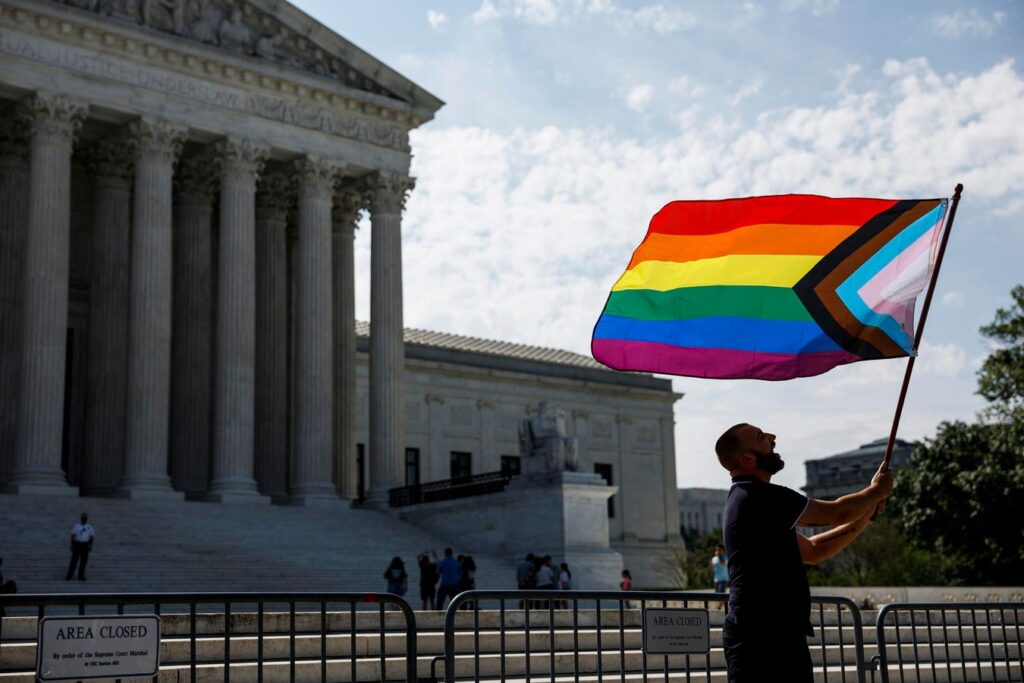Topline
The Trump administration’s transgender military ban will take effect again while litigation against it moves forward, as the Supreme Court ruled Tuesday to throw out a lower court’s ruling that put the controversial policy on hold.
Vin Testa waves a LGBTQ pride flag in front of the Supreme Court building on June 26, 2023 in … More
Key Facts
The Supreme Court ruled 6-3 to throw out a lower court’s ruling that paused the policy, which states that “individuals who have a current diagnosis or history of, or exhibit symptoms consistent with, gender dysphoria are no longer eligible for military service.”
Justices did not give any explanation for their reasoning behind the order, which allows the transgender military ban to take effect while the case moves forward in federal appeals court.
The court was split along ideological lines, with its three liberal justices—Justices Elena Kagan, Sonia Sotomayor and Ketanji Brown Jackson—saying they would have denied the Trump administration’s request and continued to pause the ban.
The Trump administration asked the Supreme Court to take up the case after U.S. District Judge Ana Reyes halted the ban in March, siding with transgender service members and ruling the policy was unlawfully discriminatory, and a federal appeals court then refused to reinstate it.
Solicitor General Dean John Sauer argued the Supreme Court should block the ban while the case moves forward, because it did the same during other legal challenges to Trump’s transgender military ban in his first term, and argued the ban is not discriminatory because it’s based on the “medical condition” of gender dysphoria.
Lambda Legal and the Human Rights Campaign Foundation, which represented the transgender plaintiffs, decried the Supreme Court’s ruling Tuesday, calling it a “devastating blow to transgender servicemembers who have demonstrated their capabilities and commitment to our nation’s defense.”
What To Watch For
The Supreme Court’s ruling will stay in place until the case comes back to the high court for a second time. Any ruling a federal appeals court issues in the case will likely be appealed by the Trump administration or the transgender plaintiffs. If the parties ask the Supreme Court to take up the case and justices agree, the ban will stay in effect until whenever the high court issues its final ruling in the case. If the Supreme Court decides not to take up the case, the order issued Tuesday will expire—meaning whether or not the ban is in place will depend on however the lower courts ruled.
Chief Critic
“By allowing this discriminatory ban to take effect while our challenge continues, the Court has temporarily sanctioned a policy that has nothing to do with military readiness and everything to do with prejudice. Transgender individuals meet the same standards and demonstrate the same values as all who serve,” Lambda Legal and the Human Rights Campaign Foundation said in a statement Tuesday, adding the organizations “remain steadfast in our belief that this ban violates constitutional guarantees of equal protection and will ultimately be struck down.”
What Does The Transgender Military Ban Say?
The Pentagon’s memo instituting the ban orders service members who have been “diagnosed with gender dysphoria” to “be processed for separation” from the military, and prohibits transgender people from being accepted into the military going forward. The policy directs existing service members to be honorably discharged from the military, but notes individual people can apply for a waiver to stay in the military if “there is a compelling government interest in retaining the service member who directly supports warfighting.” It also prohibits referring to any service members using pronouns that don’t reflect their biological sex, requires people to use facilities that match their biological sex and ends medical coverage for gender-affirming care. The memo was based on an executive order Trump issued in January that directed the Pentagon to issue guidance around excluding transgender Americans from military service. Trump argued in his executive order that “military service must be reserved for those mentally and physically fit for duty,” claiming the military’s “high standards” are “inconsistent with the medical, surgical, and mental health constraints on individuals with gender dysphoria” and “shifting pronoun usage or use of pronouns that inaccurately reflect an individual’s sex.”
Key Background
Trump first introduced a transgender military ban during his first term, imposing a sweeping policy in 2017 banning transgender service members that was later halted by the courts. The first Trump administration then issued an updated policy, which ended up taking effect, which largely banned transgender service members but carved out some exceptions, including for those who had not received any gender-affirming care and were willing to serve consistent with their biological sex. President Joe Biden’s administration then undid those restrictions after Trump left office, allowing transgender Americans to serve openly in the military. Trump’s military ban is consistent with his administration’s larger anti-transgender agenda. The president has also signed executive orders that direct the government to only recognize people’s biological sexes and impose other restrictions on transgender rights, and the Trump administration has broadly targeted diversity and pro-LGBTQ+ efforts and government funding.
Further Reading
Read the full article here
